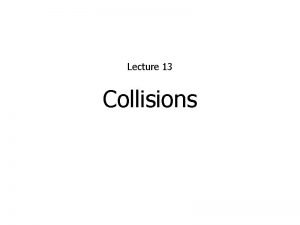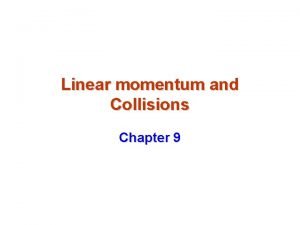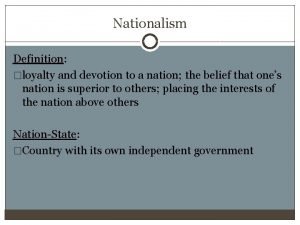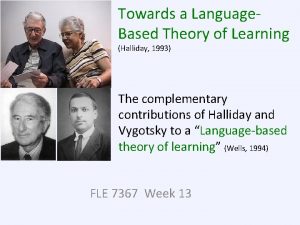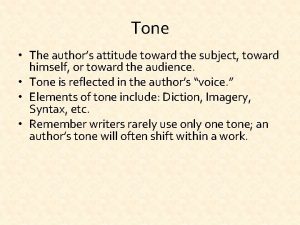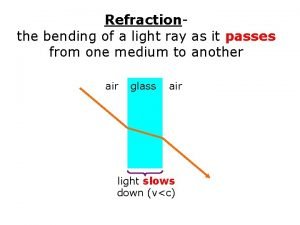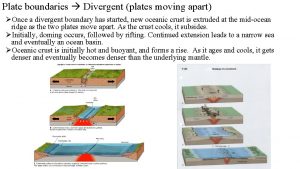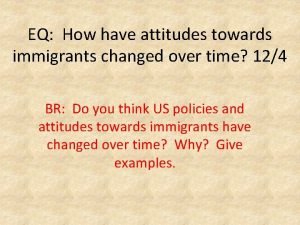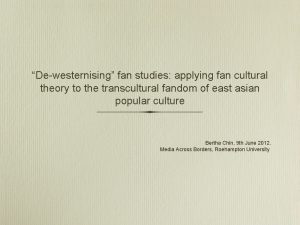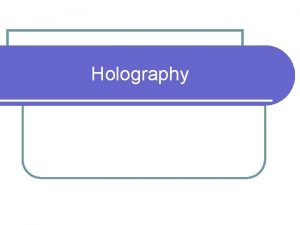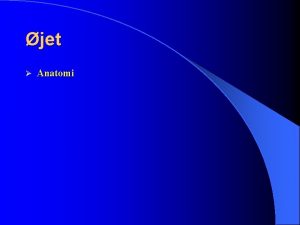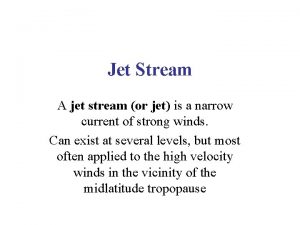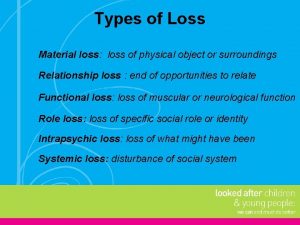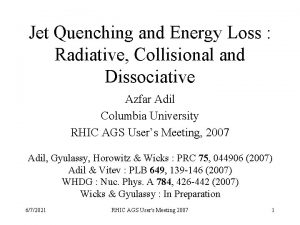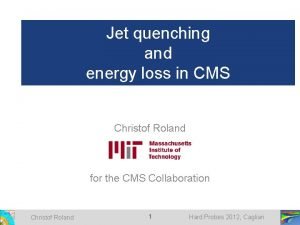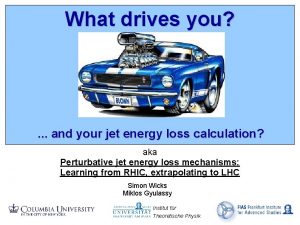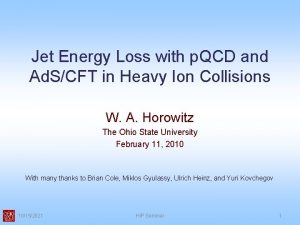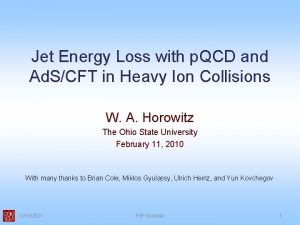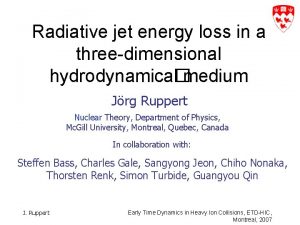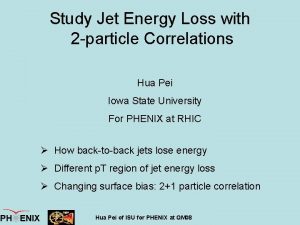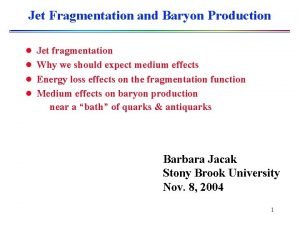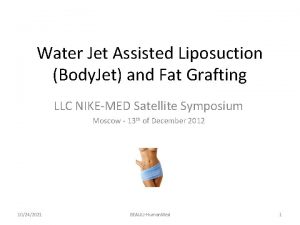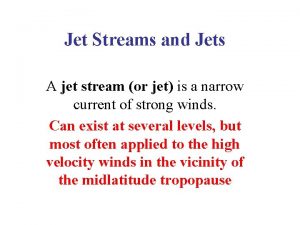HYDRODYNAMIZATION AND JET ENERGY LOSS IN HOLOGRAPHY TOWARDS






























- Slides: 30

HYDRODYNAMIZATION AND JET ENERGY LOSS IN HOLOGRAPHY TOWARDS QUANTITATIVE RESULTS FROM HOLOGRAPHY Based on work with Michał Heller, David Mateos, Jorge Casalderrey, Miquel Triana, Paul Romatschke, Björn Schenke, Krishna Rajagopal, Andrey Sadofyev, Jasmine Brewer, Umut Gürsoy and Aron Jansen Review references: 1802. 04801 (general) and 1501. 04952 (holography) (slowed down by 1023) Wilke van der Schee ALICE Journal Club 21 February 2018

Wilke van der Schee, MIT/Utrecht OUTLINE Holography to model QCD • Ad. S/CFT: first principle non-perturbative QFT computations • Limitations: QCD(-like) theory with intermediate coupling is hard Two simple models • Colliding lumps of energy in super-Yang-Mills theory • Obtain early hydrodynamics + rapidity distribution • Finite coupling corrections • Shoot ensemble of jets through expanding and cooling s. QGP • Extract influence QGP on jet shape + dijet asymmetry • Time permitting: small systems • More refined models, more realistic phenomenology 2/25 An outlook

Wilke van der Schee, MIT/Utrecht INITIAL STAGE + JET ENERGY LOSS Hydrodynamics needs initial conditions • Energy density, velocity, as function of space at initial time • (Gradient tensors for 2 nd order hydro) Energy loss of quark/gluon • Temperature/path length • Wave function of quark? QCD is well understood theory? ? 3/25 • Perhaps at weak coupling

Wilke van der Schee, MIT/Utrecht THE WORLD AS A HOLOGRAM A very curious fact: black hole entropy proportional to area! Thought experiment: collapse entropy to black hole Jacob Bekenstein, Black holes and entropy (1973) Stephen Hawking, Particle creation by black holes (1975) Gerard ’t Hooft, Black hole quantization and a connection to string theory (1990) 4/25 Intuition: gravity provides UV cut-off in space due to BH formation

Wilke van der Schee, MIT/Utrecht A PICTURE OF ADS/CFT Strongly coupled planar QFT = classical gravity in a box (of d+1) Strongly coupled QFT lives on boundary NB: only self-similar (conformal) in vacuum state Maurits Cornelis Escher, Circle Limit III (1960) and Regular Division of the Plane VI (1962) 5/25 Distance to boundary = dynamics at certain scale

Wilke van der Schee, MIT/Utrecht HOLOGRAPHY MORE PRECISELY Exact equivalence between string theory and quantum field theory Holography synonyms: Dictionary: Original: type IIB string theory Near-boundary metric of Ad. S ~ stress tensor Black hole ~ thermal state Fundamental string ~ Quark-antiquark pair Most famous result: (from black hole horizon) Also: insights information paradox, fast thermalization, . . . (16000+) Juan Maldacena, The large-N limit of superconformal field theories and supergravity (1997) 6/25 • • Ad. S/CFT, gauge/gravity duality, gauge/string duality

Wilke van der Schee, MIT/Utrecht ADS/CFT AND HEAVY IONS Exact equivalence between certain string theories and certain QFTs • String theory only simple in large Nc and infinite ’t Hooft coupling • Several examples known, but no known ‘real world’ QFT (yet? ) A typical strategy: start with `canonical’ example N =4 SYM • Theory non-confining, but confining analogues exist • Requires large Nc, but 1/32 seems small from lattice QCD • Can compute some corrections, e. g. : Holography provides a unique perspective Real world heavy ions most likely interplay between weak and strong 7/25 • Only way of computing far-from-equilibrium non-perturbative dynamics • Study rich dynamics of general strongly coupled theories

Wilke van der Schee, MIT/Utrecht COLLISIONS AT INFINITELY STRONG COUPLING • Match longitudinal profile of energy density to nuclei Benchmark: 8/25 • Approximately homogeneous in transverse plane J. Casalderrey-Solana, M. P. Heller, D. Mateos and WS, From full stopping to transparency in a holographic model of heavy ion collision

Wilke van der Schee, MIT/Utrecht THERMALISATION/PRESSURES Pressures, energy starts at zero, grows (unique to holography? ) Thermalises very fast (hydro applies in perhaps 0. 02 fm/c) 9/25 • Thermalisation = relaxation non-hydro modes (or hydrodynamization) • Gradients + viscous corrections are big J. Casalderrey-Solana, M. P. Heller, D. Mateos and WS, From full stopping to transparency in a holographic model of heavy ion collision

Wilke van der Schee, MIT/Utrecht A NEW QUANTITATIVE INSIGHT 10/25 • Collide shocks with energy and charge • Now collide neutral with charged shock • 41% of charge changes direction strong interactions J. Casalderrey-Solana, D. Mateos, WS and M. Triana, Holographic heavy ion collisions with baryon charge (2016)

Wilke van der Schee, MIT/Utrecht COLLISIONS AT FINITE COUPLING Leading order correction: small curvature squared • Not for N=4 SYM theory (but that’s also not what we want…) • Einstein-Gauss-Bonnet theory: • Reproduces weak-coupling expectations, i. e. Funny thing: evolution is just as simple as original 11/25 • Initial condition remains exact solution of EOM (for some L) • Nested scheme survives completely (with source terms) Yevgeny Kats and Pavel Petrov, Effect of curvature squared corrections in Ad. S on the viscosity of the dual gauge theory (2007)

Wilke van der Schee, MIT/Utrecht COLLISIONS AT FINITE COUPLING - NARROW • Much more energy on lightcone (more transparent, less stopping) • Energy in plasma flatter Sašo Grozdanov and WS, Coupling Constant Corrections in a Holographic Model of Heavy Ion Collisions (PRL, 2016) 12/25 • Results presented for i. e. (solid) • Initial condition constructed such that energy is the same

Wilke van der Schee, MIT/Utrecht COLLISIONS AT FINITE COUPLING - RAPIDITY • Initial rapidity shape differs from Gaussian Wide Almost entirely by hydro + less pile-up: First lower energies + wider Viscosity: lower transverse pressure, more entropy 13/25 Narrow Wider and lower initially (energy on lightcone not shown) Later similar (time 3), then more entropy, similar width

Wilke van der Schee, MIT/Utrecht QUARKS IN ADS/CFT Ad. S/CFT allows to add fundamental quarks to N=4 SYM • Classical open strings, but energy proportional to Endpoint has to stay on D 7 -brane, cannot fall Heavy quarks, if mass>temperature Andreas Karch and Emanuel Katz, Adding flavor to Ad. S/CFT (2002) 14/25 Light quarks; strings falls into black hole

Wilke van der Schee, MIT/Utrecht EARLY WORK 15/25 Initial string at point, velocity profile stopping distance P. M. Chesler, K. Jensen, A. Karch and L. G. Yaffe, Light quark energy loss in strongly-coupled N = 4 supersymmetric Yang-Mills plasma

Wilke van der Schee, MIT/Utrecht STRING EVOLUTION: EXAMPLE Black hole Old problem: how to define energy loss in terms of string? • In particular, real jets lose order 10% energy • Natural definition: size black hole = size QGP, shoot jet through Model evolution more realistically Attractive: final string in vacuum Ad. S is well understood • Angle in Ad. S ≈ jet angle (? ) 16/25 • Part of string falls in black hole: dissipates into hydro modes

Wilke van der Schee, MIT/Utrecht INCLUDING FLUCTUATIONS So far strings were optimised to minimise energy loss • Phenomenologically well motivated, but not so realistic Try including more realistic string initial conditions • Jets fluctuate, have probability distribution for energy loss • Not necessarily straightforward at large N and strong coupling • Jets are not spray of particles before hadronization; more properly energy flow with energy correlators 17/25 • Different jets, however, characterised by different string profile • Ignoring 1/N and 1/coupling effects for now…

Wilke van der Schee, MIT/Utrecht FLUCTUATIONS IN JEWEL Jet dijet modification thought to arise from path length fluctuations • One jet loses more energy than other jet: larger asymmetry • Intuition turns out not to be quite right: single jet fluctuation dominates 18/25 • Compare r=0 central jets, to regularly distributed jets Guilherme Milhano and Korinna Zapp, Origins of the di-jet asymmetry in heavy ion collisions (2015)

Wilke van der Schee, MIT/Utrecht MATCHING BOTH JET ENERGY AND JET WIDTH Initial conditions in literature: minimize energy loss Would like to mimic distribution of real QCD jets • Extra motivation: how is distribution affected by QGP? • Take from p. QCD (compares well with PYTHIA) Link jet width to Ad. S angle A. J. Larkoski, S. Marzani, G. Soyez, J. Thaler, Soft drop (2014) 19/25 zi: fraction of jet energy qij: angle between particle i and j R: jet radius parameter

MODEL PARAMETERS Wilke van der Schee, MIT/Utrecht 20/25 Two parameters fitted by data (~scaling T and scaling <C(1)1>): J. Brewer, K. Rajagopal, A. Sadofyev and WS, Jet Shape Evolution in a Strongly Coupled Plasma (2016)

EVOLUTION IN QGP: Wilke van der Schee, MIT/Utrecht 21/25 Resulting modification in jet shape + dijet asymmetry: J. Brewer, K. Rajagopal, A. Sadofyev and WS, Jet Shape Evolution in a Strongly Coupled Plasma (2016)

Wilke van der Schee, MIT/Utrecht TWO COMPETING EFFECTS 1. Every jet widens 2. Energy distribution falls steeply (~E-6) • 22/25 • Wide jets lose (much) more energy selection bias on narrow jets ATLAS, Measurement of inclusive jet and dijet cross sections in proton-proton collisions at 7 Te. V centre-of-mass energy (2011)

Wilke van der Schee, MIT/Utrecht TWO COMPUTATIONS FOR SMALL SYSTEMS A fluctuation in a thermal bath: • Hydro works within 0. 2 fm/c, for system of size 0. 5 fm. • Hydro found to work in a system with R ~ 1/T WS, Holographic thermalization with radial flow (2012) Paul Chesler, How big are the smallest drops of quark-gluon plasma? (2016) 23/25 A full-blown off-center `p-p collision’:

Wilke van der Schee, MIT/Utrecht AN ESTIMATE For p-Pb and p-p collisions only few particles produced • Naïve estimate: gives • Volume per rapidity: R 2 tini • When R > 1/T (and tini. T>1) then d. Nch/dy > 4 • Note that R increases faster than 1/T (t versus t 1/3) WS, Early hydrodynamisation, energy loss and small systems in holographic heavy ion collisions (2016) Paul Romatschke, Do nuclear collisions create a locally equilibrated quark-gluon plasma? (2016) 24/25 • Hydro works better at later times • Flow requires time to develop, i. e. 4 is `optimistic’ estimate

DISCUSSION Wilke van der Schee, MIT/Utrecht Holography and heavy ion collisions • Ad. S/CFT essential tool for insights in strongly coupled matter • Complementary with weak coupling modelling Qualitative lessons and quantitative modelling • • • Fast applicability of hydrodynamics Most of energy stopped at moderate rapidity, Gaussian shape Less stopping and broader rapidity profile at finite coupling Energy loss jet has crucial interplay with jet width Hydro in small systems feasible at strong coupling • More quantitative comparisons with experiment, perhaps fitting width rapidity spectrum etc, improved models closer to QCD • Computing non-local energy loss with varying T and varying flow 25/25 Outlook

Wilke van der Schee, MIT LARGE N GAUGE THEORIES At strong coupling we can get GR Gerard ’t Hooft, A planar diagram theory for strong interactions (1974) 26/25 Planar limit: fixed

Wilke van der Schee, MIT ADS/CFT AND HOLOGRAPHY Heavy ion physics: a weak/strong coupling interplay? • A ‘hybrid’ approach: make a model inspired by strong and weak models • Bolder approach: strong coupling entirely • Qualitative/quantitative trends can inspire better modelling • In either approach some amount of fitting is required Viscosity is good example: • Canonical theory gives benchmark value • Qualitative insight: viscosity scales as entropy • Possible to compute corrections: 27/25 • Expected range: 0. 08 – 0. 12, link with weak coupling result?

Wilke van der Schee, MIT RAPIDITY PROFILE + MUSIC Particle spectra in longitudinal direction: • Profile is about 30% too narrow WS and B. Schenke, Rapidity dependence in holographic heavy ion collisions (2015) ALICE, Bulk Properties of Pb-Pb collisions at √s. NN = 2. 76 Te. V measured by ALICE (2011) 28/25 • Rescaled initial energy density by factor 20

Wilke van der Schee, MIT 29/25 RECENT HOLOGRAPHIC JET STUDIES J. Casalderrey, D. Can Gulhan, J. Guilherme Milhano, D. Pablos and K. Rajagopal, A Hybrid Strong/Weak Coupling Approach to Jet Quenching R. Morad, W. A. Horowitz, Strong-coupling Jet Energy Loss from Ad. S/CFT (2014)

Wilke van der Schee, MIT/Utrecht ENERGY LOSS BY A SLAB OF PLASMA Old problem: how to define energy loss in terms of string? • In particular, real jets lose order 10% energy • Natural definition: size black hole = size QGP, shoot jet through Model evolution more realistically • Part of string falls in black hole: dissipates into hydro modes Attractive: final string in vacuum Ad. S is well understood 30/25 • Angle in Ad. S ≈ jet angle (? ) P. M. Chesler and K. Rajagopal, Jet quenching in strongly coupled plasma (2014)
 Yelvington jet aviation jet fuel
Yelvington jet aviation jet fuel History of holography
History of holography History of holography
History of holography The method of unit costing is adopted by
The method of unit costing is adopted by Energy energy transfer and general energy analysis
Energy energy transfer and general energy analysis Energy energy transfer and general energy analysis
Energy energy transfer and general energy analysis Perfectly elastic collision
Perfectly elastic collision Sticky collision
Sticky collision Savukku nora money
Savukku nora money Loyalty and devotion towards a nation.
Loyalty and devotion towards a nation. Flow through an orifice lab report
Flow through an orifice lab report Water jet velocity formula
Water jet velocity formula Jet peel usa
Jet peel usa Halliday 1993
Halliday 1993 What is the author’s attitude toward a subject called?
What is the author’s attitude toward a subject called? Together towards improvement
Together towards improvement Sand: towards high-performance serverless computing
Sand: towards high-performance serverless computing Hrdsa
Hrdsa Light bending towards the normal
Light bending towards the normal Moving apart
Moving apart Feelings of hatred towards somebody
Feelings of hatred towards somebody Towards deep conversational recommendations
Towards deep conversational recommendations How have attitudes towards immigrants changed
How have attitudes towards immigrants changed Towards a theory of transcultural fandom
Towards a theory of transcultural fandom Character formation with leadership
Character formation with leadership Plate tectonics apes
Plate tectonics apes Towards independence commerce program
Towards independence commerce program Attitude of the author
Attitude of the author What did kat get from glimmer's body
What did kat get from glimmer's body Is the path of moving point
Is the path of moving point Free body diagram egg falling
Free body diagram egg falling






